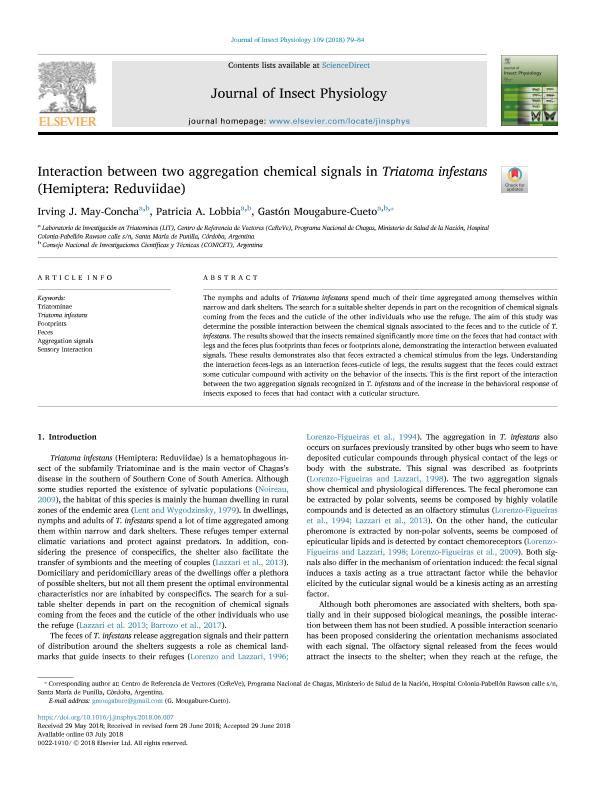Mostrar el registro sencillo del ítem
dc.contributor.author
May Concha, Irving Jesus

dc.contributor.author
Lobbia, Patricia Alejandra

dc.contributor.author
Mougabure Cueto, Gastón Adolfo

dc.date.available
2020-04-21T18:50:06Z
dc.date.issued
2018-08
dc.identifier.citation
May Concha, Irving Jesus; Lobbia, Patricia Alejandra; Mougabure Cueto, Gastón Adolfo; Interaction between two aggregation chemical signals in Triatoma infestans (Hemiptera: Reduviidae); Pergamon-Elsevier Science Ltd; Journal of Insect Physiology; 109; 8-2018; 79-84
dc.identifier.issn
0022-1910
dc.identifier.uri
http://hdl.handle.net/11336/103214
dc.description.abstract
The nymphs and adults of Triatoma infestans spend much of their time aggregated among themselves within narrow and dark shelters. The search for a suitable shelter depends in part on the recognition of chemical signals coming from the feces and the cuticle of the other individuals who use the refuge. The aim of this study was determine the possible interaction between the chemical signals associated to the feces and to the cuticle of T. infestans. The results showed that the insects remained significantly more time on the feces that had contact with legs and the feces plus footprints than feces or footprints alone, demonstrating the interaction between evaluated signals. These results demonstrates also that feces extracted a chemical stimulus from the legs. Understanding the interaction feces-legs as an interaction feces-cuticle of legs, the results suggest that the feces could extract some cuticular compound with activity on the behavior of the insects. This is the first report of the interaction between the two aggregation signals recognized in T. infestans and of the increase in the behavioral response of insects exposed to feces that had contact with a cuticular structure.
dc.format
application/pdf
dc.language.iso
eng
dc.publisher
Pergamon-Elsevier Science Ltd

dc.rights
info:eu-repo/semantics/openAccess
dc.rights.uri
https://creativecommons.org/licenses/by-nc-sa/2.5/ar/
dc.subject
AGGREGATION SIGNALS
dc.subject
FECES
dc.subject
FOOTPRINTS
dc.subject
SENSORY INTERACTION
dc.subject
TRIATOMA INFESTANS
dc.subject
TRIATOMINAE
dc.subject.classification
Zoología, Ornitología, Entomología, Etología

dc.subject.classification
Ciencias Biológicas

dc.subject.classification
CIENCIAS NATURALES Y EXACTAS

dc.title
Interaction between two aggregation chemical signals in Triatoma infestans (Hemiptera: Reduviidae)
dc.type
info:eu-repo/semantics/article
dc.type
info:ar-repo/semantics/artículo
dc.type
info:eu-repo/semantics/publishedVersion
dc.date.updated
2020-03-13T18:08:30Z
dc.journal.volume
109
dc.journal.pagination
79-84
dc.journal.pais
Estados Unidos

dc.description.fil
Fil: May Concha, Irving Jesus. Consejo Nacional de Investigaciones Científicas y Técnicas; Argentina. Ministerio de Salud. Dirección de Enfermedades Transmisibles por Vectores. Centro de Referencia de Vectores; Argentina
dc.description.fil
Fil: Lobbia, Patricia Alejandra. Ministerio de Salud. Dirección de Enfermedades Transmisibles por Vectores. Centro de Referencia de Vectores; Argentina. Consejo Nacional de Investigaciones Científicas y Técnicas; Argentina
dc.description.fil
Fil: Mougabure Cueto, Gastón Adolfo. Ministerio de Salud. Dirección de Enfermedades Transmisibles por Vectores. Centro de Referencia de Vectores; Argentina. Consejo Nacional de Investigaciones Científicas y Técnicas; Argentina
dc.journal.title
Journal of Insect Physiology

dc.relation.alternativeid
info:eu-repo/semantics/altIdentifier/url/https://www.sciencedirect.com/science/article/pii/S0022191018302038
dc.relation.alternativeid
info:eu-repo/semantics/altIdentifier/doi/https://doi.org/10.1016/j.jinsphys.2018.06.007
Archivos asociados
